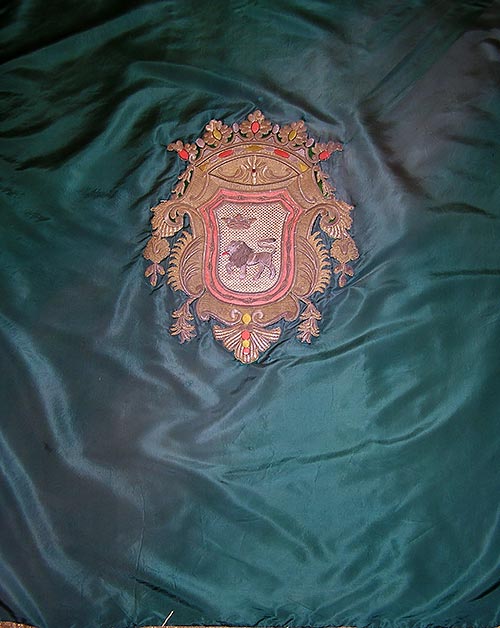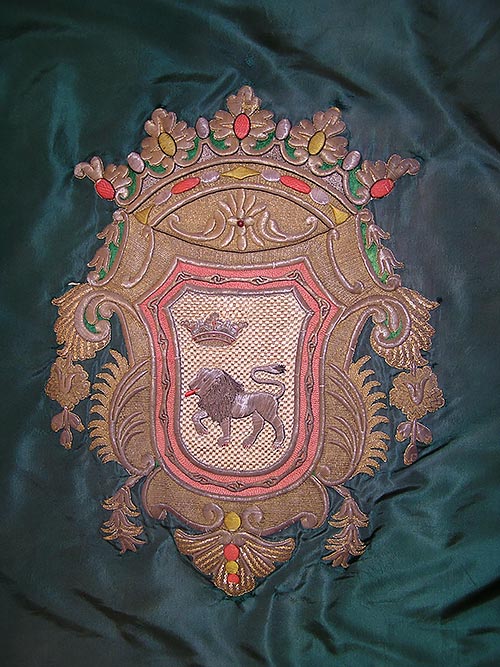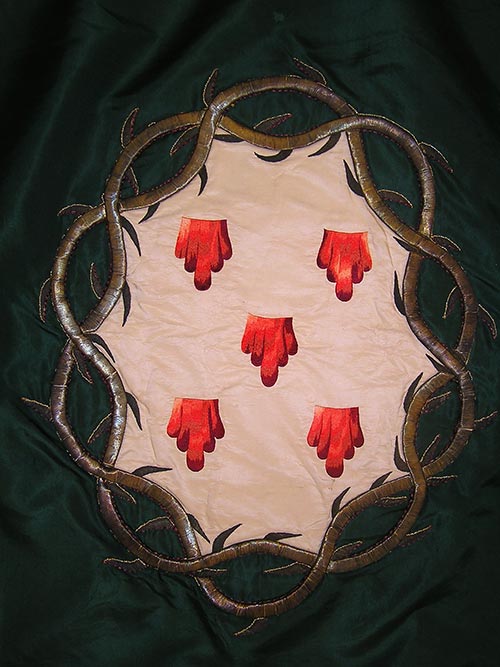The piece of the month of September 2022
FLAG OF THE CITY COUNCIL OF PAMPLONA
Alicia Andueza Pérez
Chair of Navarrese Heritage and Art
The flag we analyze here is made of a double green silk gro fabric and measures 148 x centimeters. It has the coat of arms of the city of Pamplona embroidered on the front and back.
In 1923, on the occasion of the Fifth Centenary of the Privilege of the Union, the municipal corporation decided to change the previous flag that was very deteriorated by the use. It was agreed that the new flag would be green since the previous ones were white and white. However, it is recorded that the first two flags that are known were green, as stated in the first book of conference proceedings of the Pamplona regiment, which says that on June 13, 1560 was made "a new taffeta flag with green field and a lion on it with crown and chain and golden border in the manner as the other old flag", thus also confirming that the previous one was of the same green color. Leaving aside the various issues that were raised about what historically should be the color of the flag, in which there were controversies and various opinions of different experts, as recorded in the municipal conference proceedings and in the press of the time, the truth is that from 1923, and definitely in 1930, was adopted the flag of Pamplona as we know it today.

In fact, the piece we are dealing with is the same one that was made after this disposition was taken, being able to date its background cloth in 1923. The coats of arms, of the same date as the fabric of the flag, seem older, since they follow the outline and model of the coats of arms that carry the cloths of the timbales and clarions that are conserved in the City council of Pamplona and that were made by the Zaragozan embroiderer Francisco Lizuain in 1768. But as it is recorded in the funds of the file Municipal of Pamplona, both the confection of the flag, whose fabric was ordered to the French city of Lyon - European silk center par excellence - and the embroidery of the coats of arms, were made by the Community of the Mothers Adorers of Pamplona. They had also made the previous flag of the municipality in 1915, in addition to various works and restorations of embroidery for different churches and institutions throughout their existence in the city. Likewise, in September of the same year 1923, the blessing of the new municipal flag took place in the chapel of the Casa Consistorial, as reported a day later in Diario de Navarra. The work of the Adoratrices was described as "a very fine and tasteful work".

Thus, we find a flag whose body is made of a silk gro, which is a fabric with a softened weave, very similar to taffeta, but with more body and thicker. Its ends are decorated with a border of trimmings (0.5 cm) from which a gold cord fringe starts. In its central front part, the coat of arms of Pamplona, embroidered on a canvas base and applied to the overlay on the background fabric (55 x cm), stands out imposingly. The coat of arms is inserted in a rockery tray and topped by a majestic crown. In the center and surrounded in its border with the chains of Navarre on gules, is a lion passant in silver lampasado and armed gules, topped by a royal crown and on a cream background with small blue touches, instead of the official and usual azure field of the arms of the city.
The yellow gold thread and old gold are combined in the different techniques of gold stitches, alternating the areas embroidered in chopped gold -technique by which the thread runs through the front and back of the motif creating a smooth surface, in this case on a certain relief-, with the various variants of plain gold such as the flake or the setillos, the embroidery of canutillo or the work of gold cordoncillo delimiting some contours. The area surrounding the coat of arms is made with a weave of gold thread and yellow silk, while the background forms a checkerboard pattern based on cream silk and small, almost imperceptible stitches of blue. The lion, on the other hand, is embroidered in silver on a cardboard base and its mane is made with silver cord. The colored silk thread is used in conjunction with the metallic thread, forming the yellow and red stones of the crown as bodoques by means of the smooth stitch on a basted work. The different stitches used and the highlights of some areas that sit on a coarse preparation create various effects of Issue and modeling, as well as more matte areas and other more brilliant, depending on the incidence of light on them. The whole is finished off with a red stone set in the upper part of the shield.

On the back of the flag, the back of the arms of the city of Pamplona (52 x cm) is represented, also in its central area: the five bleeding wounds that Jesus received in his martyrdom on the cross, surrounded by the crown of thorns, and that allude to the solemn vow that in 1599 the regiment made to get rid of an epidemic of plague. In this way, on a white satin background, the five wounds appear embroidered in crimson silk by means of shading stitch or silk of shades, which creates a gradation of diverse tonalities. On the other hand, the crown of thorns that surrounds the shield is made with gilded silver thread that is applied to the chopped on a surface with a certain relief.
The banner is completed with a remnant of fabric as a band that is placed at the top of the mast by means of a loop. It is made of the same green silk gro and also has the trimming border from which the gold fringe starts.
As for its state of conservation, it should be noted that the weight of the embroidery and the lightness of the fabric on which it sits, as well as the passage of time and the position of the flag itself, have caused the fabric to tear in some of the areas surrounding the shield. The tears are centered mainly in the front part, since it is there where most of the embroidery work is concentrated. The fabric is also torn in the area covering the mast. The fabric is also dirty and discolored due to its processional use. The trimming border that runs along the edges is in some areas unraveled and part of the fringe has been lost. The embroidered shields, on the other hand, are preserved in a good general condition, although some loose threads and stitched areas can be observed.
SOURCES AND BIBLIOGRAPHY
file Municipal de Pamplona, Books of conference proceedings Municipales, Libranzas and periodicals collection. We thank Javier Marquínez Hermoso de Mendoza for financial aid .
ANDUEZA PÉREZ, A., "Paños de clarines y timbales", Pamplona y San Cernin, 1611-2011, IV Centenario del voto de la ciudad, Pamplona, Pamplona City Council, 2011, pp. 130-131.
ANDUEZA PÉREZ, A., El arte al servicio del esplendor de la liturgia: El bordado y los ornamentos sagrados en Navarra. Siglos XVI-XVIII, Pamplona, Gobierno de Navarra, 2017.
DÁVILA CORONA, R. M.ª and others, Diccionario histórico de telas y tejidos, board de Castilla y León, 2004.
MARTINENA RUIZ, J. J., "El ritual cívico-religioso del municipio: Pamplona", in MARTÍN DUQUE, A. (dir.), Signos de identidad histórica para Navarra, t. II, Pamplona, Caja de Ahorros de Navarra, 1996, pp. 105-120.
